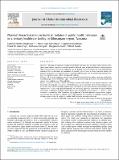| dc.contributor.author | Sengeruan, Lameck | |
| dc.contributor.author | Zwetselaar, Marco | |
| dc.contributor.author | Kumburu, Happiness | |
| dc.contributor.author | Aarestrup, Frank | |
| dc.contributor.author | Kreppel, Katharina | |
| dc.contributor.author | Sauli, Elingarami | |
| dc.contributor.author | Sonda, Tolbert | |
| dc.date.accessioned | 2022-08-30T07:34:14Z | |
| dc.date.available | 2022-08-30T07:34:14Z | |
| dc.date.issued | 2022-09 | |
| dc.identifier.uri | https://doi.org/10.1016/j.jgar.2022.06.030 | |
| dc.identifier.uri | https://dspace.nm-aist.ac.tz/handle/20.500.12479/1529 | |
| dc.description | This research article was published by Elsevier, 2022 | en_US |
| dc.description.abstract | Objectives
Plasmids are infectious double stranded DNA molecules that are found within bacteria. Horizontal gene transfer promotes successful spread of different types of plasmids within or among bacteria species, making their detection an important task for guiding clinical treatment. We used whole genome sequenced data to determine the prevalence of plasmid replicon types in clinical bacterial isolates, the presence of resistance and virulence genes in plasmid replicon types, and the relationship between resistance and virulence genes within each plasmid replicon.
Methods
All bacterial sequences were de novo assembled using Unicycler before extraction of plasmids. Assembly graphs were submitted to Gplas+plasflow for plasmid contigs prediction. The predicted plasmid contigs were validated using PlasmidFinder.
Results
A total of 159 (56.2%) out of 283 bacterial isolates were found to carry plasmid replicons, with Escherichia coli, Klebsiella pneumoniae, and Staphylococcus aureus being the most prevalent plasmid carriers. A total of 26 (86.7%) multiple-replicon types were found to carry both resistance and virulence genes compared to 4 (13.3%) single plasmid replicons. No statistically significant correlation was found between the number of antibiotic resistance and virulence genes in multiple-replicon types (r = - 0.14, P > 0.05).
Conclusion
Our findings show a relatively high proportion of plasmid replicon-carrying isolates suggesting selection pressure due to antibiotic use in the hospital. Co-occurrence of antibiotic resistance and virulence genes in clinical isolates is a public health problem warranting attention. | en_US |
| dc.language.iso | en | en_US |
| dc.publisher | Elsevier | en_US |
| dc.subject | Whole-genome sequencing | en_US |
| dc.subject | Plasmid replicon types | en_US |
| dc.subject | Antibiotic resistance | en_US |
| dc.subject | Virulence | en_US |
| dc.subject | Public health | en_US |
| dc.title | Plasmid characterization in bacterial isolates of public health relevance in a tertiary healthcare facility in Kilimanjaro region, Tanzania | en_US |
| dc.type | Article | en_US |

